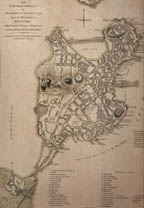
Boston is a collection of distinctly different districts and neighborhoods which each posses individual characteristics and unique identities. Boston as a whole benefits from the contributions of each of these areas, and it is truly what gives the city itís character and charm, This factor leads to a dilemma. Boston lacks a cohesive framework. The relationship between these neighborhoods has never been resolved, and in many cases it has been exacerbated. The neighborhoods are successful entities themselves, containing a strong sense of place but still remain isolated to create a fragmented city.
Boston evolved this way due to three major factors in its history, incremental growth, the central artery, and urban renewal . Boston never had a long term strategy towards planning like many conventional American cities, which are commonly based on an orthogonal grid. Since itís settlement in 1630 the city has evolved and adapted in a reactionary way as times and needs changed. The original Shawmut peninsula once contained all of Boston, but now it only constitutes a fraction of the land mass of the city. A major portion of the city today exists on landfill claimed from Boston Harbor and the Charles River. Growth created the necessity for more land area. The Back Bay, West End, and much of South Boston are examples of this expansion. As these areas where created they added to the existing city through their uniqueness but where never truly integrated with the existing city core.